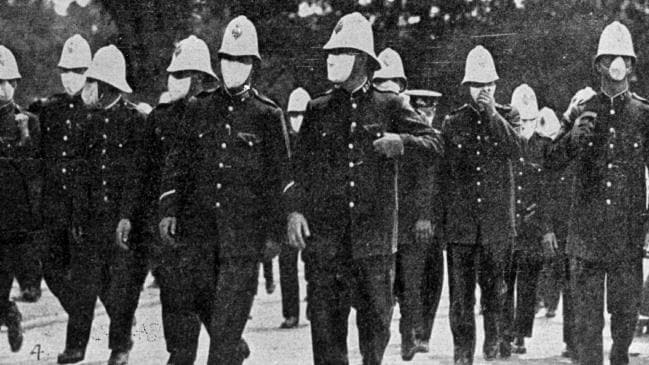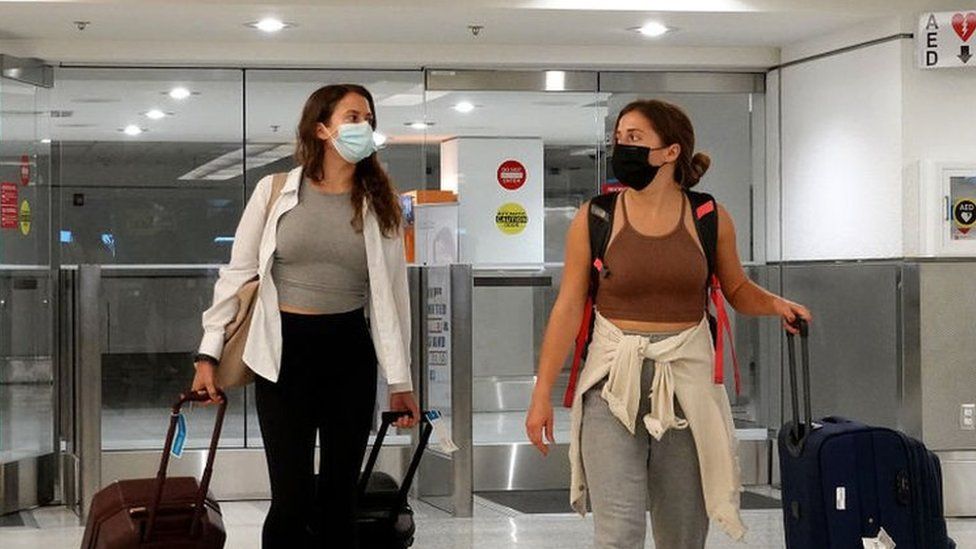
This article is more than
5 year oldHow coronavirus compares to Spanish flu

Amid the carnage of the World War I, a flu epidemic took hold in the frontline trenches and subsequently spread around the world, infecting one-quarter of the world’s total population and ultimately killing more people than the war itself.
Before it was over, somewhere between 50 million and 100 million people died from what became known as “the Spanish flu”.
The currently accepted mortality rate for the Spanish flu is between one and 3 per cent, and its total mortality numbers are shocking in part because of its widespread reach, proliferating throughout country after country around the globe.
RELATED: ‘Like a combination of SARS and AIDS’
RELATED: The unlikely hero who Australia forgot
RELATED: Deadly pandemic could wipe out 80 million

Source:News Corp Australia
A FAMILIAR NAME
The Spanish flu pandemic was triggered by a virus that is now a household name: H1N1.
H1N1 resurfaced in 2009, again spreading to the far reaches of the planet, but with only a small fraction of the death toll of its first emergence.
Although it was not an identical virus, it could have been equally deadly in theory, in part because of its potential to kill people who were younger in age and not otherwise considered vulnerable to flu-related mortality.
The absolute mortality rate of the 2009 H1N1 pandemic was 0.001-0.007 per cent.
The total number of dead in this case was in the hundreds of thousands around the globe, with a disproportionate number believed to be affected in southeast Asia and Africa.
Why the vast differences in mortality? These two versions of H1N1 did not have the same origin, and there is also an evolutionary push for subsequent versions of the same virus to be less deadly. So the two versions of H1N1 would have been different in these respects.
But, importantly, the world was different too.
HISTORY'S BIGGEST KILLERS
THE BLACK DEATH (1346-1353). Death Toll: 75-200 million
Thought to have originated in Mongolia and spread by fleas that travelled across the world on rats in ships, the medieval outbreak of Bubonic Plague ravaged Europe, Africa, and Asia for seven years, killing up to 200 million. The plague created huge religious, social and economic upheavals, with profound effects on the course of European history. In some cities, half the population perished.
SPANISH FLU (1918). Death Toll: 50 million
The deadliest pandemic in recent history, the Spanish Flu devastated populations already worn down by World War One. Believed to have originated in France, it infected 500 million people worldwide, killing around 50 million (though estimates vary). Around half the deaths occurred in the first 25 weeks alone. Unlike many flu outbreaks, which usually killed the eldferly, the weak and the young, Spanish flu killed healthy young adults.
HIV/AIDS (1980s-present). Death Toll: 36 million
First identified in central Africa in 1976, HIV/AIDS grew to become as global pandemic in the late 1980s-early 1990s. It has killed more than 36 million people worldwide, the vast majority in sub-Saharan Africa, where the disease still afflicts around 5 per cent of the population. Advances in treatments now ensure death is less likely, especially in western nations where it provoked near-panic in the 1980s, but 770,000 people still died from the disease in 2018.
PLAGUE OF JUSTINIAN (541-542). Death Toll: 25 million
This outbreak of bubonic plague is thought to have killed half the population of Europe. It originated in the Mediterranean and devastated port cities. Generally regarded as the first recorded incident of the Bubonic Plague, at its height the Justinian Plague killed 5000 people per day in Constantinople (modern Istanbul).
ASIAN FLU (1956-1958). Death Toll: 2 million
This outbreak of Influenza A originated in China in 1956spreading from Guizhou province to Singapore, Hong Kong, and the United States. Estimates for the death toll vary depending on the source, but the World Health Organization places the final tally at approximately 2 million deaths, 69,800 of those in the US.
HONG KONG FLU (1968). Death Toll: 1 million
From the first reported case on July 13, 1968 in Hong Kong, it took only 17 days before outbreaks of the virus were reported in Singapore and Vietnam, and within three months had spread to The Philippines, India, Australia, Europe, and the United States. Despite its relatively low mortality rate (0.5%) Hong Kong flu left more than 1 million dead, half of those in Hong Kong.
The conditions under which the Spanish flu overtook the world were abhorrent.
World War I had been raging for several years, and the front lines where the illness emerged were places where young soldiers lived among corpses, rats and contaminated water, and had limited opportunities for personal hygiene.
In 2009, even the most poor nations of the world had better living conditions than those experienced by the average soldier in the trenches.
Despite this, the nations that had the least ability to provide clean environments for their populations were hit the hardest by the H1N1 infections, with large numbers infected and many fatalities.
The spread of COVID-19 in China — and recent cases appearing closer to home — has people worried about another Spanish flu scenario.
This will not be another Spanish flu, but we have an important opportunity to control the proliferation of the virus within our own populations.

its employees against the flu epidemic in 1919.Source:News Corp Australia
BEHAVIOUR AND HERD IMMUNITY
Herd immunity is a concept that comes from the field of zoology.
It refers to the ability of a population of animals to resist infection by a pathogen — such as a virus — because a sufficiently large number of individuals within the population have humoural immunity on an individual level.
Humoural immunity is the ability of the immune system to form antibodies against a specific infectious agent.
With herd immunity, transmissibility in a population is dramatically reduced via immunological mechanisms.
This is the theory behind vaccines, which boost specific immunity within (ideally) a very large proportion of the population, such that a transmissible disease never gains a foothold.
Notice the term “immunological mechanism,” and consider whether the same principle could apply on a behavioural level.

February 2020 showing the novel coronavirus 2019-nCoZV, the virus that causes COVID-19. Picture: NIAID-RML via APSource:AP
As the body’s humoural immune responses deflect infection, so do behaviours that block routes into the body for an infectious agent.
With a very large proportion of the population consistently implementing behaviours that reduce transmissibility, epidemics can be prevented or vastly limited, without the reactionary measure of quarantine.
Just as humoural immunity does not convey perfect protection to the individual, the same is true for behavioural immunity; it is simply important that a very high proportion of the population is performing precautionary behaviours consistently.
Protection is on the level of the herd, more so than on the level of the individual.
ARE WE TALKING ABOUT THE WRONG THINGS?
In the context of this concept of “behavioural herd immunity,” current discussions about COVID-19 in conventional and social media may be focused on the wrong things.
Rather than talking about fear-inducing counterfactual scenarios (what ifs), we need to focus on crowdsourcing strategies that limit the ability of the infection to get a foothold in our population.
A vaccine would be nice and will eventually arrive. But in the meantime, epidemics like COVID-19 can be prevented by increasing precautionary behaviours in the general population that impede its spread.
These measures include a few familiar maxims, none of which are implemented consistently enough, and a few unfamiliar ones, which very much need to be taken up individually en masse. And soon.

Picture: Mladen Antonov/AFPSource:AFP
The familiar ones:
• Wash your hands frequently and properly;
• Cover your mouth (with your arm) when coughing or sneezing;
• Avoid close contact with those who are already infected.
Before brushing off the above as obvious, we should ask ourselves: do we do these with complete consistency? Can we do better?
Consider also the following less obvious but equally important behaviours:
• Disinfect your mobile device screen twice per day. It is a portable petri dish, accumulating bacteria and, yes, viruses. Antibacterial wipes are necessary here, as they generally kill viruses as well. Clean your device at least twice daily, once at lunch and once at dinner time (or linked to another daily routine). A recently published study estimates that viruses like COVID-19 may be able to persist for up to nine days on smooth glass and plastic surfaces, like a mobile phone screen.
• Avoid touching your face. Your mouth, nose, eyes and ears are all routes into your body for viruses, and your fingers are constantly in touch with surfaces that may contain viruses.
This simple measure is very hard to maintain consistently, but is essential for infection control.
• Use masks only if you are yourself illand give social kudos to people who are responsible enough to use them when sick.
• Self-quarantine if you are ill and have a fever.
•Engage your social network to brainstorm other simple behavioural changes.


PREVENTING SPREAD
Strengthening herd immunity through behaviour is critical to preventing COVID-19 spread.
We need to be talking about it more, and doing it more.
In the sea of fear-provoking uncertainties, this is something that we are in control of individually and en masse.
Let’s do better about implementing the above precautionary behaviours with high consistency, and over the long-term.
And here’s a side benefit: we will be preventing many other infectious illnesses from spreading, including seasonal influenza, which kills more people in an average month than COVID-19 did last month.
This article originally appeared on The Conversation and was reproduced here with permission




